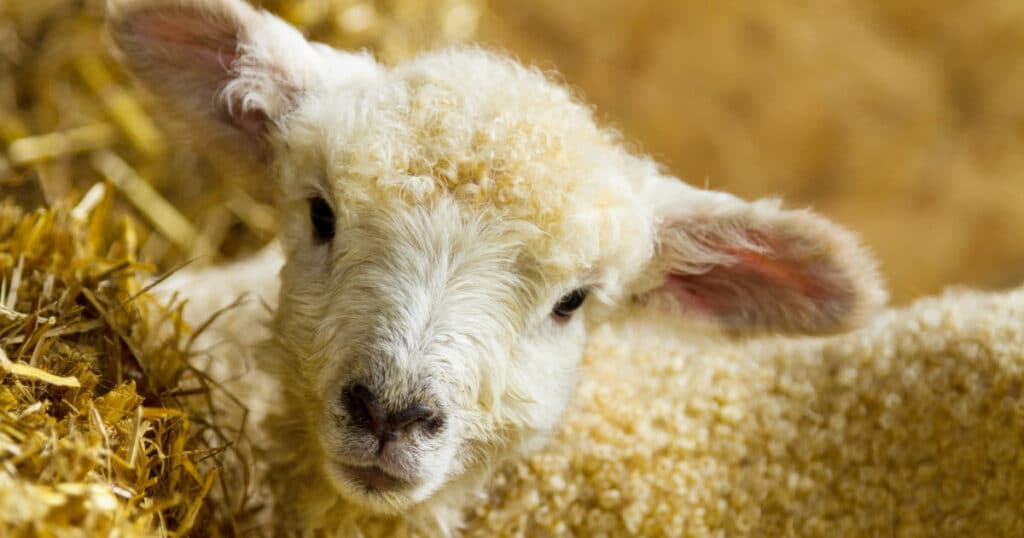So far you’ve done well with your sheep. They’ve settled in nicely, you’ve had no health problems and you are feeling good about your investment. But now it is almost time for you to go through your first lambing season and you’re not too sure you are ready for this. Don’t worry, though, as long as you are properly prepared for lambing and don’t panic, you’ll be fine (and so will your lambs).
Below we’ve listed an in-depth guide with tips for lambing, a shopping list for lambing supplies and equipment to have on hand before lambing season gets underway, and some best practices to improve lamb survival rate and ensure the health of your brood ewes before, during, and after they deliver their lambs.
Let’s get started!
What You Need for Lambing
(supplies and equipment to have on hand)
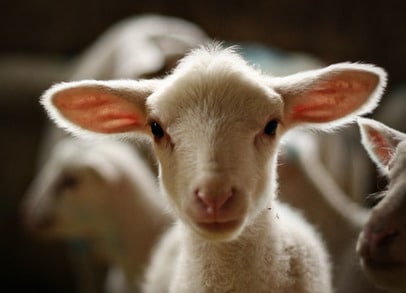
The following is a list of things you need for delivering lambs and why you need them.
NOTE: Several of these things you may never need or need very rarely, but it is always better to be safe (and ready) rather than be sorry.
- A Tool Box or sturdy backpack to keep everything in (I use a spare plastic toolbox designed to hold electric shears)
- Pen and small notebook to record date, sex, birth type (single, twin, triplet) and mother’s flock number of lambs when born
Make a section in your notebook to record any health concerns or other noteworthy info. about your flock - Ear tagger and small tags for lambs or a can of livestock paint.
- VETRX respiratory prevention drops
- Small (5′ x 5′) lambing pen or jug to isolate ewe and her lambs after birth
- Towels or rags for clearing away excess membrane if necessary
- Scissors to clip the umbilical cord 3-4 inches from the navel
- 7% Tincture Iodine to pour over the navel and cord to speed drying and kill bacteria
- Syringes and 14 gauge or smaller needles
- Antibiotic (ProPenG, NUFLOR or NAXEL)
- Large syringe and stomach tube
- Selenium & Vitamin E Supplement Paste
- Nutri-Drench
- Lamb Milk Replacer with good shelf life
- Heat Lamp to safely suspend over a corner of lambing pen or jug (optional, use only in the coldest weather as this can be a fire hazard to your barn)
In addition to your lambing supply bag/toolbox you may want to keep a blow dryer and a few pairs of old sweat pants available. This is an old farmer’s trick to help revive lambs quickly in case of hypothermia (more on this later).
Why it’s Important to Stock Up Before Lambing Season
It’s always better to have a full lambing toolbox on hand, stocked with supplies and equipment so that you’re well prepared for when things go right or when things go wrong.
Being prepared and having the proper tools to assist your ewe should the birth be difficult can make the difference between a healthy lamb and lambing disaster.
Signs of Lambing (how to know it won’t be long)
The ewe will often display signs that she is close to lambing. Some of these signs will be more obvious than others. Some will take place days before lambing while other ewes will display some signs of lambing only an hour or so before giving birth. Some of the signs to watch for include:
- Arched tail heads. As the vulva swells, the tail head will arch out. The area will also be brighter pink in color.
- Dropped udder and distended teats. While young ewes (first and second time lambers) will usually not be as obvious, milk production will begin prior to lambing and the udder will fill with milk or ‘drop.’ The teats will become swollen with milk; ready to feed hungry lambs.
- Discharge. Vaginal discharge will usually be evident prior to lambing. This can happen anywhere from a couple of weeks to a few hours before a ewe gives birth.
- Dropping. It will usually be evident that the lamb(s) have dropped into the birth canal just by looking at the ewe. You will see a concave area between the last rib and the ewe’s hips as the lambs drop into position prior to birth. This is usually observed 1-3 days prior to lambing.
- Loss of appetite. In the hours before giving birth, most ewes will go off by themselves and not eat. This is normal and it is a sign that your ewe is very close. Be observant and take note of your flock’s routines – if your ewe stops eating but other telltale signs are not evident you should investigate … if a pregnant ewe stops eating several weeks before lambing it could be cause for concern.
- Pawing at the ground. Most ewes will do this as a final nesting effort to prepare the ground for labor and delivery. You’ll often notice this at feeding time when you observe ewes who weren’t interested in food separate themselves and begin preparing for delivery. It is important to be observant of your ewe’s regular behavior – some sheep make a habit of pawing at the ground every time they lie down so this may not be an early sign of labor for all ewes.
- Laying down and contracting. Once the ewe is in active labor, she will lay down and begin having obvious contractions. She may raise her front end up on her forelegs, arch her head up and back during contractions or lift her upper lip. Active labor is pretty easy to identify as the ewe will be straining quite obviously. This will usually last between one and four hours – anything longer than that without signs of obvious progress is cause for concern.
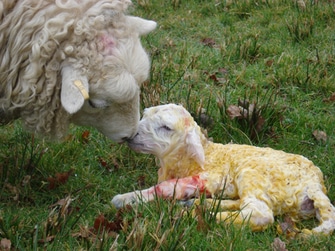
Once the lamb has been born, the mother will immediately begin licking to clean the membrane off the lamb’s face so it can breathe. If you’re handy using a towel to wipe the membrane and mucous away from the lamb’s mouth and nose is a good idea – this will ensure that your lamb’s first breaths are clean and clear.
Cleaning the lamb is the mother’s way of boosting circulation and bonding with the lamb. If the ewe is going to deliver additional lambs she may tend to her first lamb for 20-30 minutes before delivery of the second lamb or she may move away from the first lamb to give birth to the second one right away. This is not necessarily a bad thing, Most of the time the lamb will instinctively follow or call out to its mother, who will then return to it or answer the lamb until it finds its way to her.
What to Do When Your Ewe Begins to Deliver Her Lambs
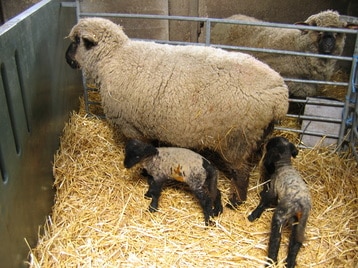
For the most part the best thing you can do is to stand clear and let nature take its course. Interfering with delivery when it’s not necessary can actually harm both the lamb and the ewe. There is no doubt that plenty of well-meaning shepherds have pulled lambs from ewes that did not need assistance.
Hardy breeds of sheep like the Katahdin, Cheviot, Icelandic and Dorper are known for being hardy, easy-lambing and excellent mothers. First time mothers will sometimes be confused, but give them a chance to figure things out on their own before stepping in to assist.
If your sheep can deliver and care for their lambs on their own you should resist the urge to step in and assist … let them do what they do best.
More high-maintenance breeds such as the Suffolk and Romanov have more trouble lambing and are more apt to neglect their mothering duties.
If this is the case you may have to assist by cleaning the lambs off with a rag so they can get their breath and put them with mom in a lambing pen or jug to for extra bonding time and to allow lambs to gain strength and learn to nurse.
Video of Sheep Giving Birth to a Lamb
If you’ve selected the right breeding stock (and you select for and keep the brood ewes that prove to be excellent mothers) you will often wake in the morning to find that healthy lambs have been born in the night without your assistance.
Above is a short video of a Texel ewe delivering a pair of twins in a pasture in February. The shepherd narrates the delivery of the second lamb and as you’ll see – this ewe has one of the most easy deliveries you’ll ever see. Selecting for prolific ewes which have an easy time lambing will pay off in the long run as it will cut losses, the amount of time you have to spend on your knees and will save you money.
Routine Care of Newborn Lambs
Once the lambs are up and have nursed, it is safe for you to quietly, calmly and confidently approach the ewe and her lambs for the sake of tagging, recording the necessary information, putting nose drops in their nose and treating the umbilical cord and navel.
If you have a small flock or a skittish new mother, confine her in a small 5’x5′ lambing pen (lambing jug) with fresh water and some grain or nutritious hay.
Once you’ve done everything you have to do it’s best to give the ewe and her lambs space to let the bonding process begin.
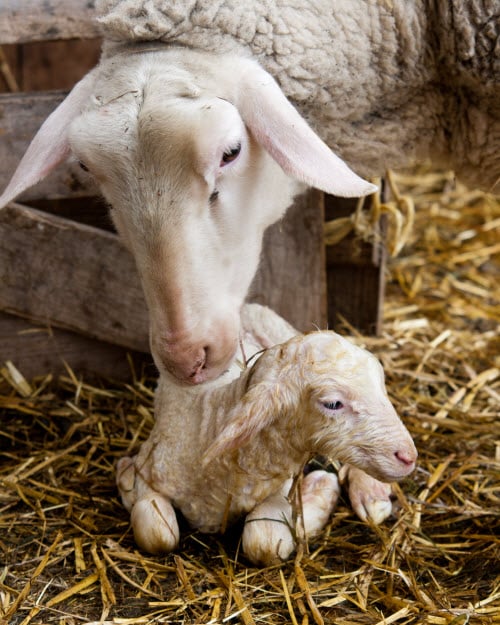
It’s a good idea to check back within an hour or two to make sure the lamb has nursed. You can usually tell by inserting a clean finger into the lamb’s mouth. If it feels very warm the lamb is healthy – if it’s cold the lamb likely hasn’t latched onto the nipple and had a drink yet. You can help it by clearing the wax plug and pointing it in the right direction. Help it latch on if needed.
Lambing Difficulty (what to do when something goes wrong)
If a ewe is obviously contracting and nothing is happening after a few hours, you need to check the ewe to make sure the lamb is not breech (a difficult position for delivery) or that it has not died in the womb. You will do this by inserting two lubricated fingers into the vagina. If you feel the feet and the head, you need to go ahead and help the ewe deliver by working with the contractions. Proper position for delivery is head-first with two front legs (as if the lamb is diving into the world).
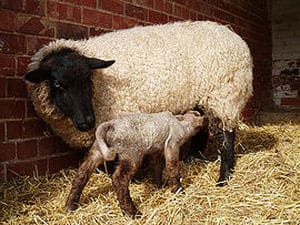
If you feel the butt or tail of the lamb, you will also need to go ahead and help deliver-also working with the contractions. If the lamb is dead, pull the lamb-working with the contractions. If the lamb is viable, place the lamb at the mothers head and give them time to bond. The ewe will need a shot of antibiotic to ward off infection or to be placed in solitary confinement with her lamb(s) to be observed for signs of infection for a few days. If the lamb is dead, antibiotics are a MUST and then turn her in with non-lambing ewes to dry up without being over-fed. This will prevent mastitis.
In any lambing situation observation and good record keeping is key. It’s easy to lose track of time and think “she’s been pushing for over an hour I need to help.” If you didn’t make note of when active labor actually began you may step in too early.
If the lambs are born without any problem, but the mother is not interested in letting them nurse, you will need to confine them and hold the ewe until you are positive the lambs have sucked within the first couple of hours of being born. It is also best to keep the little family separate from the rest of the flock for a few days to make sure bonding has truly taken place.
There are going to be times when for one reason or another, a lamb is abandoned. While there is often no physical evidence of why, nature has its own way of taking care of things. Most of the time a lamb that is abandoned by an experienced ewe is destined to die anyway. There is most likely an internal defect we cannot know about.
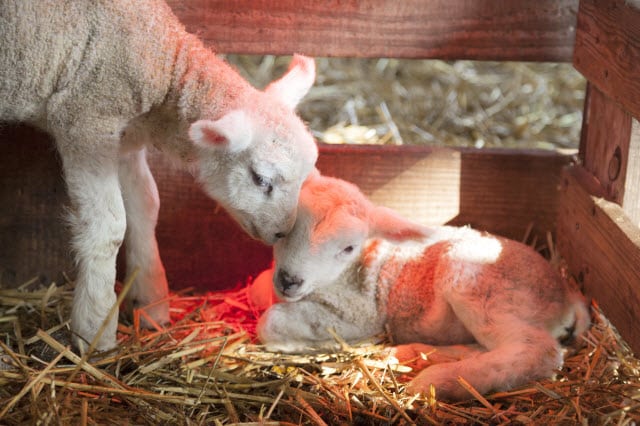
But because we don’t know these things, abandoned lambs should be taken inside to be treated for hypothermia, given some artificial colostrum to get them moving and then returned to mom to see if bonding can or will take place. If it does, great. Just keep an eye on the pair to make sure the lamb is growing and thriving.
If not there are a couple of options: if another ewe is lambing within the next 12 hours and has a single you can try to graft the lamb – dousing it with her amniotic fluid and placing it alongside the newborn to see if she will adopt it. This takes careful attention as some new mothers won’t be fooled and will try to kill the lamb you’re attempting to graft. If this isn’t an option you’ve got yourself a bottle-fed lamb.
Hypothermia in Lambs After Delivery
Let’s talk about how to treat a lamb for hypothermia.
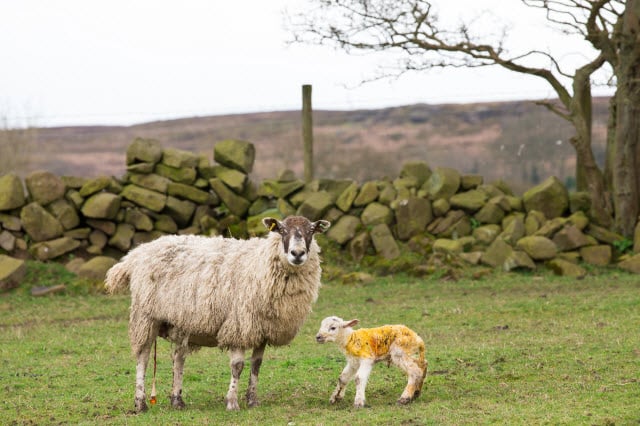
Hypothermia occurs when the lamb’s body temperature drops too low to generate enough internal heat to keep it alive. Your job is to raise their INTERNAL body temperature back to normal. You can do this by putting the lamb inside a pair of sweat pants with its head sticking out of one leg. Close the opening at the waist off, and insert a blow dryer into the other leg. Run it on high until the roof of the lamb’s mouth is warm to the touch (the same as yours). NOTE: you can alternate between high and low settings on the hair dryer for safety sake.
Once the lamb is warm internally, you can feed it warm (not hot) colostrum. Doing so before the lamb’s body temperature is sufficient is a waste of time and energy. You will then need to return it to mom to try to reunite them or keep it in a pen for a few days to bottle feed.
*TIP: Nutri-Drench is a great product to have on hand to give a quick boost to struggling lambs.
Final Thoughts & Lambing Advice

During lambing season it’s important to keep in mind that some things are just not meant to be. It’s possible to do everything right and still have a lamb or a ewe die. This is part of raising sheep and if this happens you can use it as a teaching moment with your 4-Her. Place a value on the experience you gained, emphasize what you have learned and look forward toward a better outcome next time.
By being watchful and prepared your lambing experience can be enjoyable and educational.

